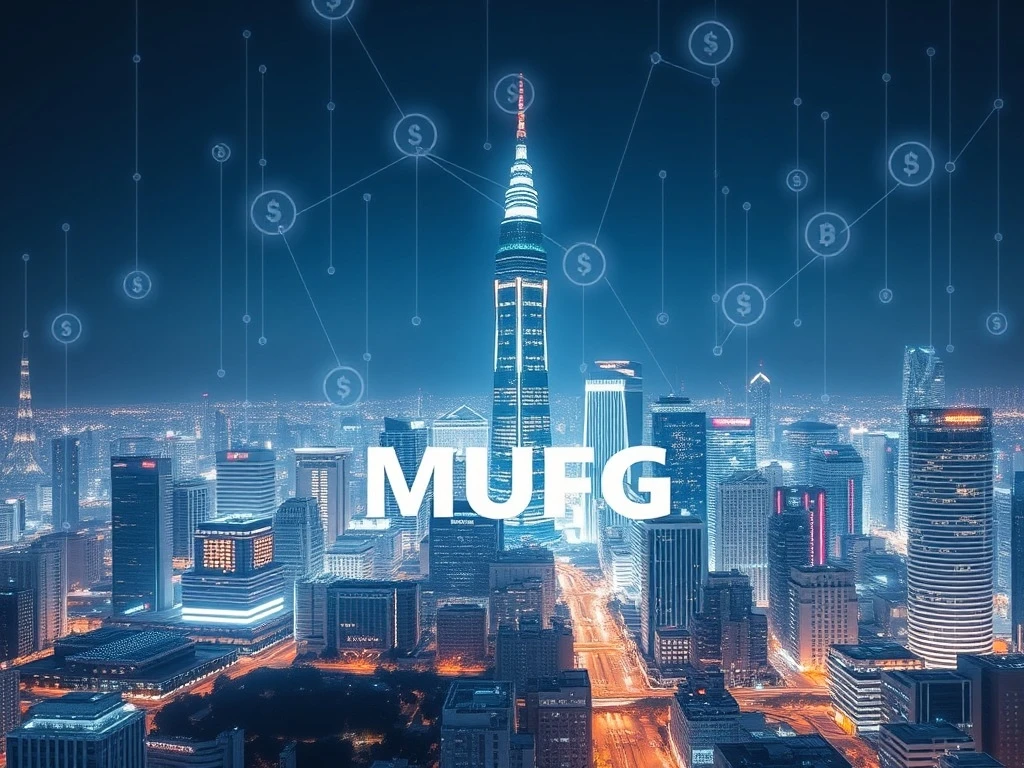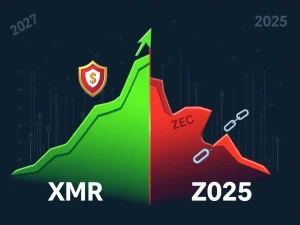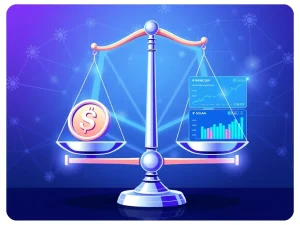MUFG’s Revolutionary Leap: Tokenizing a ¥100 Billion Osaka Skyscraper via Blockchain

In a groundbreaking move that could redefine the landscape of traditional finance and real estate, Japan’s largest bank, Mitsubishi UFJ Financial Group Inc. (MUFG), is spearheading a monumental initiative: the MUFG tokenization of a ¥100 billion ($681 million) high-rise skyscraper in Osaka. For anyone tracking the evolution of digital assets and the integration of blockchain technology into real-world applications, this development signals a significant shift. It’s not just about a single property; it’s about democratizing access to historically illiquid assets and paving the way for a new era of investment opportunities. This bold step by MUFG highlights the growing confidence in blockchain’s ability to enhance transparency, efficiency, and accessibility in the global financial system.
What is MUFG Tokenization and Why It Matters?
At its core, MUFG tokenization involves converting a tangible asset, like a skyscraper, into digital tokens on a blockchain. This process breaks down the asset into smaller, tradable units, making it more accessible to a wider range of investors. For the ¥100 billion Osaka skyscraper, MUFG’s trust banking arm, Mitsubishi UFJ Trust and Banking Corporation, plans to structure it as a private real estate investment trust (REIT) specifically for institutional investors. This means large players, such as life insurance companies, can now invest in a prime property without the traditionally prohibitive minimum investment thresholds associated with direct physical property ownership.
Why is this significant? Traditional real estate investments often come with high entry barriers, lengthy transaction times, and limited liquidity. Tokenization addresses these pain points by:
- Enhancing Liquidity: Tokens can be traded on secondary markets much like stocks, allowing investors to buy and sell fractional ownership more easily.
- Reducing Entry Barriers: By fractionalizing assets, even high-value properties become accessible to a broader investor base, including those with smaller capital.
- Streamlining Processes: Blockchain technology automates many aspects of ownership verification, compliance, and settlement, drastically cutting down on paperwork and delays.
This initiative is not merely a pilot; it’s a strategic move by MUFG to solidify its position at the forefront of the real-world assets (RWAs) market. By demonstrating the viability of tokenizing a high-value asset, MUFG is setting a precedent for how large financial institutions can leverage blockchain to unlock new value and efficiency.
Expanding Horizons: Blockchain Real Estate for All
While the Osaka skyscraper is aimed at institutional investors, MUFG’s vision extends far beyond. The bank is also actively expanding its tokenization efforts to include foreign real estate for retail investors. This is where the partnership with Progmat platform becomes crucial. Through this collaboration, everyday investors will gain the ability to acquire fractional ownership in international real estate assets via a user-friendly digital platform.
Imagine being able to own a piece of a commercial building in New York or a residential complex in London, all from the comfort of your home, with relatively small capital. This is the promise of blockchain real estate. It’s a game-changer for retail investors who have historically been excluded from such lucrative opportunities due to high minimum investments and complex cross-border regulations. By focusing on foreign real estate for retail, MUFG is strategically navigating potential domestic regulatory complexities in Japan, while simultaneously tapping into a global demand for diversified real estate exposure.
This dual approach — private REITs for institutions and tokenized foreign assets for retail — showcases a comprehensive strategy to democratize access to the real estate market. It leverages the inherent strengths of blockchain: transparency, immutability, and programmability, to create a more inclusive investment ecosystem.
The Role of the Progmat Platform in Digital Asset Innovation
The success of MUFG’s ambitious tokenization plans heavily relies on robust technological infrastructure, and that’s precisely where the Progmat platform steps in. Progmat is a blockchain platform with established experience in cross-border tokenization, making it an ideal partner for MUFG’s global aspirations. Progmat will be responsible for managing the underlying infrastructure for structuring and distributing these digital assets.
How does Progmat facilitate this? It provides the necessary technological backbone to:
- Issue Digital Securities: Creating the tokenized representations of real estate assets.
- Manage Lifecycle Events: Handling dividend distributions, voting rights (if applicable), and other ownership-related events programmatically.
- Ensure Compliance: Integrating regulatory requirements directly into the smart contracts, ensuring adherence to local and international laws.
- Facilitate Secondary Trading: Potentially enabling a marketplace where these tokenized assets can be bought and sold efficiently.
While specific overseas partnerships for retail-focused foreign real estate remain undisclosed, Progmat’s proven track record suggests a strong foundation for these future endeavors. This collaboration underscores a broader trend: the convergence of traditional financial giants with innovative blockchain technology providers to build the financial systems of tomorrow.
Navigating Challenges and Embracing Tokenized Assets
While the potential for tokenized assets is immense, industry experts acknowledge the path forward involves significant challenges. Dr. Jamal Oudeen, a fintech analyst, aptly noted that tokenization could “reshape how assets are traded, particularly for retail investors who previously faced high minimum investments or lack of liquidity.” However, he also emphasized that “market acceptance and regulatory scrutiny must be addressed for scalability.”
MUFG’s strategic focus on foreign real estate for retail investors is a calculated move to navigate some of these domestic regulatory complexities. By targeting international properties, the bank may circumvent jurisdictional hurdles in Japan while catering to global demand for diversified real estate exposure. This approach aligns with broader trends in blockchain adoption, where cross-border transactions are increasingly seen as a pathway to bypass localized barriers and foster innovation.
Key challenges that need careful consideration include:
- Regulatory Clarity: The evolving nature of digital asset regulations across different jurisdictions requires continuous adaptation and clear frameworks.
- Investor Education: Ensuring both institutional and retail investors understand the nuances and risks associated with tokenized assets.
- Market Adoption: Building sufficient liquidity and a robust secondary market for these digital securities.
- Security: Protecting the underlying blockchain infrastructure from cyber threats and ensuring the integrity of the digital assets.
Despite these hurdles, MUFG’s commitment signals a strong belief in the transformative power of tokenization to unlock new efficiencies and investment opportunities.
What’s Next for Japanese Finance and Real-World Assets?
MUFG’s initiative builds on its extensive history of fintech projects, including blockchain-based supply chain finance and digital identity verification. Its leadership in Japan’s real-world assets (RWAs) market positions the bank as a key influencer in shaping future regulatory and technological frameworks as tokenization gains broader traction. This move by Japan’s largest bank could catalyze broader adoption among other Japanese finance institutions, accelerating the integration of blockchain into traditional financial services.
The Osaka skyscraper project serves as a crucial test case for institutional investors, demonstrating the practical application and benefits of tokenized private REITs. Simultaneously, the retail-focused foreign assets initiative could set a significant precedent for wider market participation in digital real estate. If successful, this groundbreaking initiative may fundamentally redefine liquidity and accessibility in the real estate sector, a market historically constrained by its illiquidity and high capital requirements.
Yoshimasa Fukuzaki, an MUFG executive, articulated the bank’s vision: “This aligns with our commitment to innovation in financial services and reflects our belief in the potential of digital securities to transform investment landscapes.” While a specific launch timeline has not yet been announced, MUFG has underscored its unwavering commitment to adhering to local and international regulations – a critical factor in maintaining investor trust and ensuring the long-term success of these pioneering ventures.
Conclusion
MUFG’s audacious move to tokenize a ¥100 billion Osaka skyscraper, alongside its plans for retail-focused foreign real estate via the Progmat platform, marks a pivotal moment in the convergence of traditional finance and blockchain technology. This initiative is not just about digitizing assets; it’s about democratizing investment, enhancing market efficiency, and setting new standards for liquidity in the real estate sector. While challenges remain, MUFG’s leadership could inspire a wave of adoption across Japanese finance and global markets, fundamentally reshaping how we perceive, invest in, and trade real-world assets. The future of investment is becoming increasingly digital, and MUFG is clearly at the forefront of this exciting transformation.
Frequently Asked Questions (FAQs)
1. What is MUFG tokenization, and how does it work for the Osaka skyscraper?
MUFG tokenization refers to Mitsubishi UFJ Financial Group’s process of converting a physical asset, like the ¥100 billion Osaka skyscraper, into digital tokens on a blockchain. For the skyscraper, it will be structured as a private Real Estate Investment Trust (REIT) for institutional investors. This allows large investors to buy fractional ownership stakes digitally, bypassing the high minimum investments and complex processes of traditional physical property acquisition. Each token represents a verified share of ownership.
2. How will retail investors benefit from MUFG’s tokenization efforts?
Retail investors will benefit through MUFG’s partnership with the Progmat platform, which will enable them to purchase tokenized fractional ownership in foreign real estate assets. This significantly lowers the entry barrier to real estate investment, allowing individuals to diversify their portfolios with international properties that were previously out of reach due to high capital requirements and cross-border complexities. It enhances liquidity and accessibility for everyday investors.
3. What role does the Progmat platform play in this initiative?
The Progmat platform serves as the crucial technological infrastructure for MUFG’s tokenization efforts, especially for retail-focused foreign real estate. Progmat is responsible for issuing the digital securities, managing their lifecycle events (like distributions), ensuring regulatory compliance through smart contracts, and potentially facilitating secondary trading. Its prior experience in cross-border tokenization makes it a key enabler for MUFG’s global real estate tokenization ambitions.
4. What are the main advantages of investing in blockchain real estate?
Investing in blockchain real estate offers several key advantages: enhanced liquidity (easier buying/selling of fractional shares), reduced entry barriers (lower minimum investments), increased transparency (all transactions recorded on an immutable ledger), streamlined processes (faster settlements and compliance), and greater accessibility to a wider range of assets, including international properties.
5. What challenges might MUFG face with this tokenization project?
Despite its potential, MUFG’s tokenization project faces challenges such as navigating evolving global regulatory frameworks for digital assets, ensuring broad market acceptance and liquidity for the new tokenized assets, and educating both institutional and retail investors about this novel investment approach. Security of the blockchain infrastructure and adapting to potential jurisdictional hurdles for cross-border transactions are also critical considerations.
6. How might this initiative impact the broader Japanese finance sector?
MUFG’s pioneering move could act as a catalyst for broader adoption of blockchain and tokenization within the Japanese finance sector. As Japan’s largest bank, its success in this area could encourage other major financial institutions to explore and implement similar real-world asset (RWA) tokenization projects. This could accelerate the integration of digital securities into traditional finance, redefining liquidity, investment paradigms, and regulatory approaches across the country.









